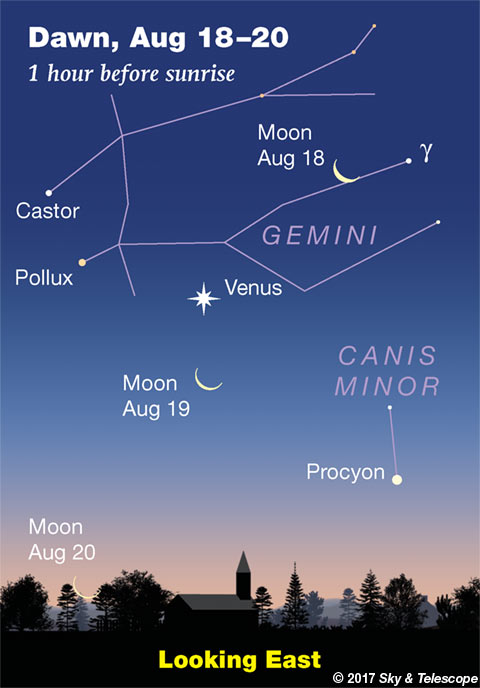
Friday, August 18
• As dawn begins to break on Saturday morning the 19th, look for the waning Moon hanging under Venus low in the east, as shown here. Find Pollux and Castor, much fainter, to Venus's left or upper left.
Saturday, August 19
• August is prime Milky Way time, and the dark night is now moonless. After dark the Milky Way runs from Sagittarius in the south, up and left across Aquila and through the big Summer Triangle very high in the east, and on down through Cassiopeia to Perseus rising low in the north-northeast.
Sunday, August 20
• With the Moon obviously out of the night sky getting ready for tomorrow's command performance, this would be a fine evening to look far away from the Sun into the Cygnus Milky Way, high overhead. Hunt out the telescopic deep-sky sights there that Sue French highlights in the August Sky & Telescope, page 54, with finder charts, photo, and eyepiece sketches.
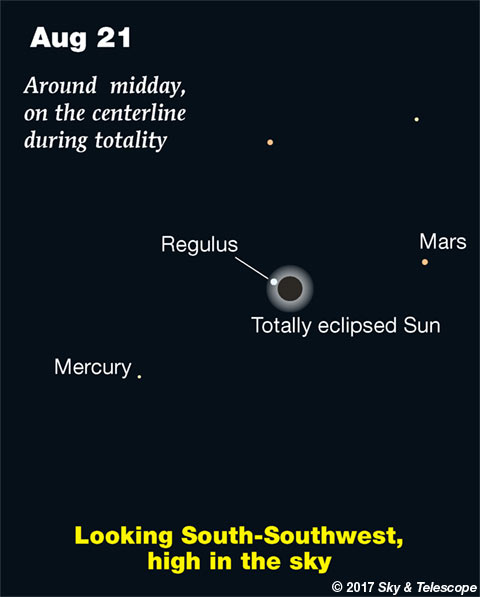
Monday, August 21
• In case you didn't hear, there's an eclipse of the Sun today. Not in the path of totality? You'll get a partial eclipse from anywhere in North or Central America, the Caribbean, and northern South America. Here are all our eclipse topics, including how to take photographs. Shortcut to NASA's clickable map to get your local timetable.
• If a solar eclipse is happening, you know it's new Moon today.
Tuesday, August 22
• After dusk as August nears its end, the Great Square of Pegasus looms up in the east, balancing on one corner. Its stars are only 2nd and 3rd magnitude. Extending leftward from the Square's left corner is the main line of the constellation Andromeda, made of stars about the same brightness.
This whole giant pattern was named "the Andromegasus Dipper" by the late Sky & Telescope columnist George Lovi. Shaped somewhat like a giant Little Dipper, it currently scoops upward.
Wednesday, August 23
• The actual Little Dipper, meanwhile, is tipping over leftward in the north. It's only 40% as long as the Andromegasus Dipper, and most of it is much fainter. As always, it's rotated about 90° counterclockwise from Andromegasus.
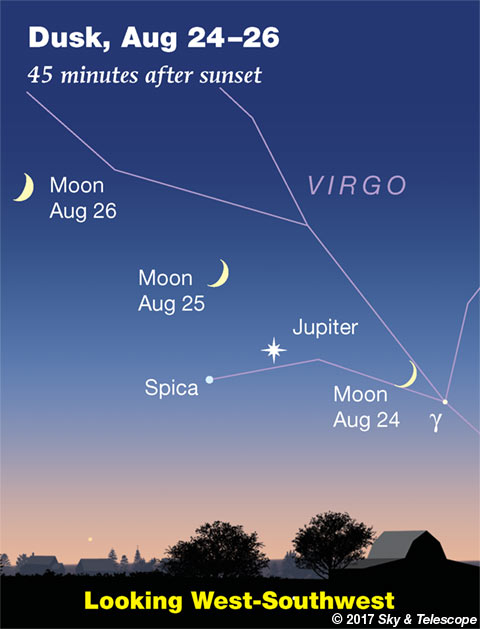
Thursday, August 24
• After causing so much fuss on Monday, the Moon now gleams shyly low in the west after sunset, as shown here. Almost a fist-width to its left is Jupiter, and fainter Spica is farther left or lower left.
Friday, August 25
• Look low in the west in twilight for the waxing crescent Moon. It forms a triangle with Jupiter and Spica below it, as shown here.
• In the early dawn of Saturday the 26th, Venus forms a straight line with Castor and Pollux above it or to its upper left.
Saturday, August 26
• The thickening crescent Moon, no longer so shy now, points its round side down nearly toward Jupiter low in twilight.
________________________
Want to become a better astronomer? Learn your way around the constellations! They're the key to locating everything fainter and deeper to hunt with binoculars or a telescope.
This is an outdoor nature hobby. For an easy-to-use constellation guide covering the whole evening sky, use the big monthly map in the center of each issue of Sky & Telescope, the essential guide to astronomy.

Once you get a telescope, to put it to good use you'll need a detailed, large-scale sky atlas (set of charts). The basic standard is the Pocket Sky Atlas (in either the original or Jumbo Edition), which shows stars to magnitude 7.6.
Next up is the larger and deeper Sky Atlas 2000.0, plotting stars to magnitude 8.5; nearly three times as many. The next up, once you know your way around, is the even larger Uranometria 2000.0 (stars to magnitude 9.75). And read how to use sky charts with a telescope.
You'll also want a good deep-sky guidebook, such as Sue French's Deep-Sky Wonders collection (which includes its own charts), Sky Atlas 2000.0 Companion by Strong and Sinnott, or the bigger Night Sky Observer's Guide by Kepple and Sanner.
Can a computerized telescope replace charts? Not for beginners, I don't think, and not on mounts and tripods that are less than top-quality mechanically (meaning heavy and expensive). And as Terence Dickinson and Alan Dyer say in their Backyard Astronomer's Guide, "A full appreciation of the universe cannot come without developing the skills to find things in the sky and understanding how the sky works. This knowledge comes only by spending time under the stars with star maps in hand."
This Week's Planet Roundup
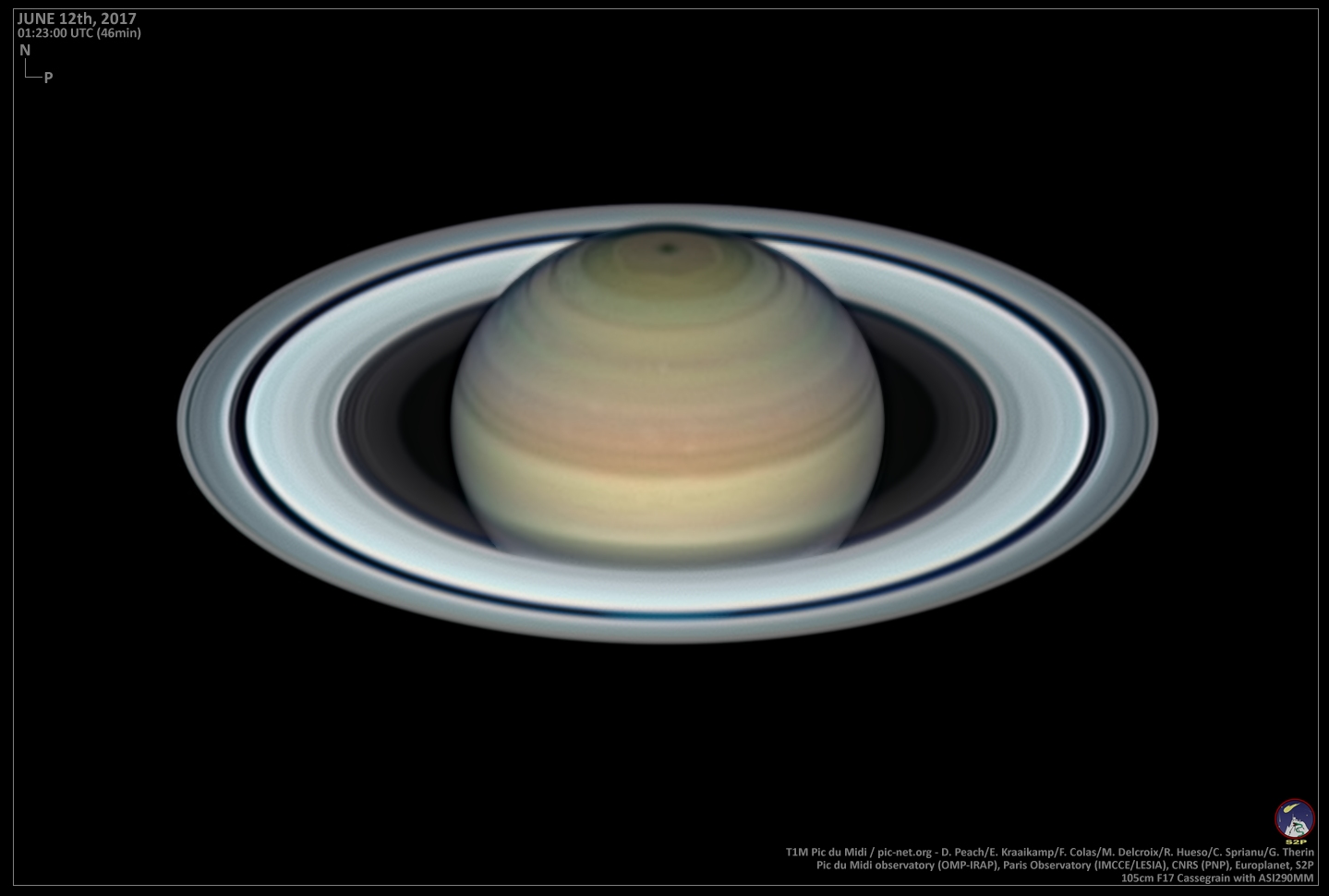
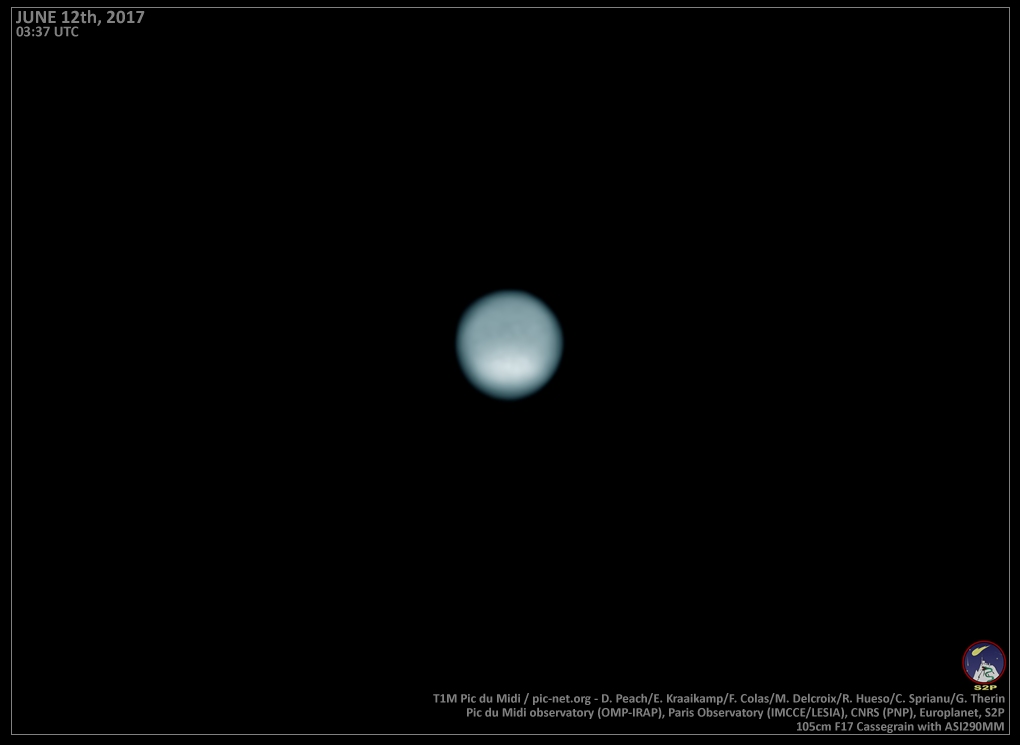
Mercury is hidden in the glare of the Sun.
Venus (magnitude –3.9) shines brightly in the east before and during dawn. Look for Pollux and Castor, much fainter, to its upper left. They form a gently curving arc with Venus that straightens out during the course of the week. The arc becomes a straight line on the morning of the 26th.
Earth, best visible in the daytime, is centered below you. Its disk is a remarkable 180° in apparent diameter, 20,000 times larger than Jupiter: the planet currently in second place in this regard. But local details usually complicate the limb, and perspective effects limit how much of the planet is visible at once. A telescope is not required.
Mars is hidden deep in the glow of sunrise.
Jupiter (magnitude –1.8, in Virgo) is very low in the west-southwest during twilight. Look for fainter Spica (magnitude +1.0) 5° left or lower left of it. Binoculars help.
Saturn (magnitude +0.4, in the legs of Ophiuchus) glows steadily in the south-southwest at nightfall. Antares, less bright, twinkles 12° to Saturn's lower right.
Uranus (magnitude 5.8, in Pisces) and Neptune (magnitude 7.9, in Aquarius) are in the southeastern sky in the early hours of the morning. Finder charts.
______________________
All descriptions that relate to your horizon — including the words up, down, right, and left — are written for the world's mid-northern latitudes. Descriptions that also depend on longitude (mainly Moon positions) are for North America.
Eastern Daylight Time (EDT) is Universal Time (UT, UTC, or GMT) minus 4 hours.
______________________
"This adventure is made possible by generations of searchers strictly adhering to a simple set of rules. Test ideas by experiments and observations. Build on those ideas that pass the test. Reject the ones that fail. Follow the evidence wherever it leads, and question everything. Accept these terms, and the cosmos is yours."
— Neil deGrasse Tyson, 2014
______________________
"Objective reality exists. Facts are often determinable. Carbon dioxide warms the globe. Bacteria evolve when challenged by antibiotics. Science and critical thinking are no political conspiracy. They are how we discover reality. Civilization's survival depends on our ability, and willingness, to do so."
— Alan MacRobert, your Sky at a Glance editor
______________________
"Facts are stubborn things; and whatever may be our wishes, our inclinations, or the dictates of our passions, they cannot alter the state of facts and evidence."
— John Adams, 1770
 3
3








Comments
mary beth
August 20, 2017 at 11:28 pm
Can you please update the app? It stops August 19. Thank you.
You must be logged in to post a comment.
Patrick-Agnew
August 22, 2017 at 4:10 pm
Thank you for including the Earth in the "Planet Roundup"! 🙂
You must be logged in to post a comment.
sgrant
August 22, 2017 at 7:24 pm
Whoever decided to add Earth to the planet round up gave me a great chuckle this week, thanks for having a little fun!
You must be logged in to post a comment.
You must be logged in to post a comment.